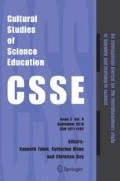Abstract
A religious perspective on life shapes how and what those with such a perspective learn in science; for some students a religious perspective can hinder learning in science. For such reasons Staver’s article is to be welcomed as it proposes a new way of resolving the widely perceived discord between science and religion. Staver notes that Western thinking has traditionally postulated the existence and comprehensibility of a world that is external to and independent of human consciousness. This has led to a conception of truth, truth as correspondence, in which our knowledge corresponds to the facts in this external world. Staver rejects such a conception, preferring the conception of truth as coherence in which the links are between and among independent knowledge claims themselves rather than between a knowledge claim and reality. Staver then proposes constructivism as a vehicle potentially capable of resolving the tension between religion and science. My contention is that the resolution between science and religion that Staver proposes comes at too great a cost—both to science and to religion. Instead I defend a different version of constructivism where humans are seen as capable of generating models of reality that do provide richer and more meaningful understandings of reality, over time and with respect both to science and to religion. I argue that scientific knowledge is a subset of religious knowledge and explore the implications of this for science education in general and when teaching about evolution in particular.



Similar content being viewed by others
References
Barbour, I. G. (1990). Religion in an age of science: The Gifford Lectures 1989–1991 (Vol. 1). London: SCM.
DCSF. (2007). Guidance on creationism and intelligent design. Accessed 1 January 2009 at http://www.teachernet.gov.uk/docbank/index.cfm?id=11890.
Gould, S. J. (1999). Rocks of ages: Science and religion in the fullness of life. New York: Ballantin.
Haught, J. F. (1995). Science & religion: From conflict to conversation. Mahwah, NJ: Paulist Press.
Hinnells, J. R. (1991). A handbook of living religions. London: Penguin Books.
Jones, L., & Reiss, M. J. (Eds.) (2007). Teaching about scientific origins: Taking account of creationism. New York: Peter Lang.
Kitcher, P. (1983). Abusing science: The case against creationism. Milton Keynes: Open University Press.
Kuhn, T. S. (1970). The structure of scientific revolutions (2nd ed.). Chicago: University of Chicago Press.
Miller, J. D., Scott, E. C., & Okamoto, S. (2006). Public acceptance of evolution. Science, 313, 765–766. doi:10.1126/science.1126746.
National Academy of Sciences and Institute of Medicine. (2008). Science, evolution, and creationism. Washington DC: National Academies Press.
O’Brien, D. (2006). An introduction to the theory of knowledge. Cambridge: Polity Press.
Proust, M. (2000). In search of lost time, volume VI: Time regained, translated by C. K. Scott Moncrieff & Terence Kilmartin, revised by D. J. Enright. London: Vintage.
QCA. (2009). National Curriculum: Science Key Stage 4—How science works. Available at http://curriculum.qca.org.uk/key-stages-3-and-4/subjects/science/keystage4/index.aspx (last accessed 1 January 2009).
Reiss, M. J. (1992). How should science teachers teach the relationship between science and religion? The School Science Review, 74, 126–130.
Reiss, M. J. (1993). Science education for a pluralist society. Milton Keynes: Open University Press.
Reiss, M. J. (2007). Imagining the world: The significance of religious worldviews for science education. Science and Education, 18, 783–796. doi:10.1007/s11191-007-9091-9.
Reiss, M. J. (2008). Should science educators deal with the science/religion issue? Studies in Science Education, 44, 157–186. doi:10.1080/03057260802264214.
Scott, E. (1999). The creation/evolution continuum. Reports of the National Center for Science Education, 19, 16–23.
Smart, N. (1989). The world’s religions: Old traditions and modern transformations. Cambridge: Cambridge University Press.
Author information
Authors and Affiliations
Corresponding author
Rights and permissions
About this article
Cite this article
Reiss, M.J. Science and religion: implications for science educators. Cult Stud of Sci Educ 5, 91–101 (2010). https://doi.org/10.1007/s11422-009-9211-8
Received:
Accepted:
Published:
Issue Date:
DOI: https://doi.org/10.1007/s11422-009-9211-8




